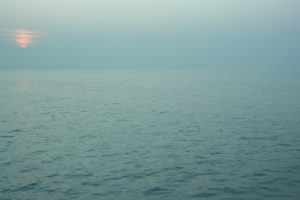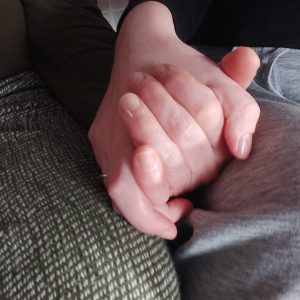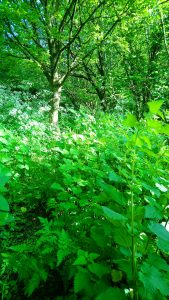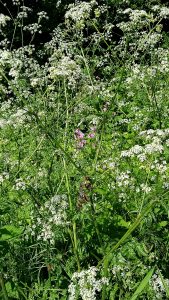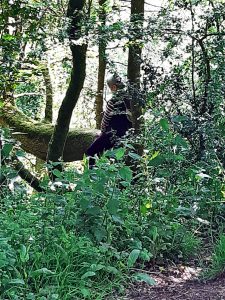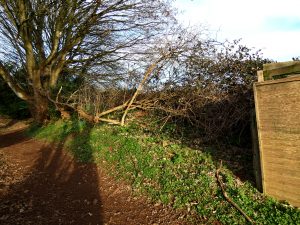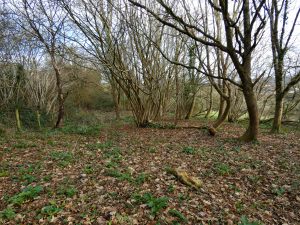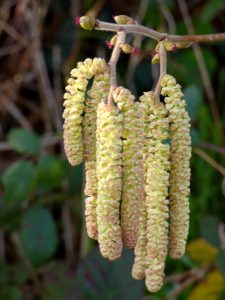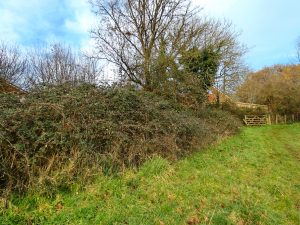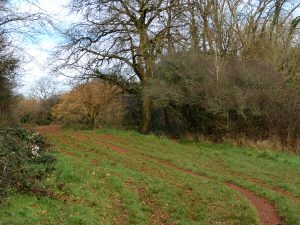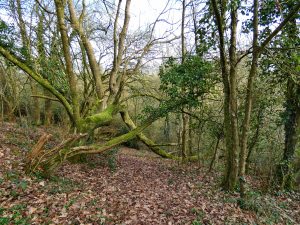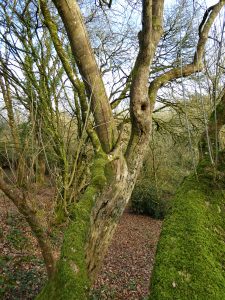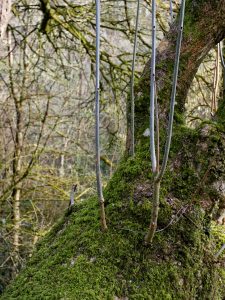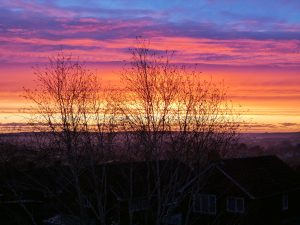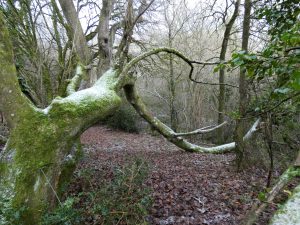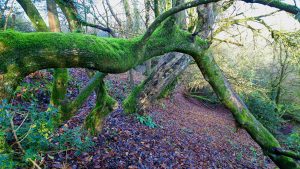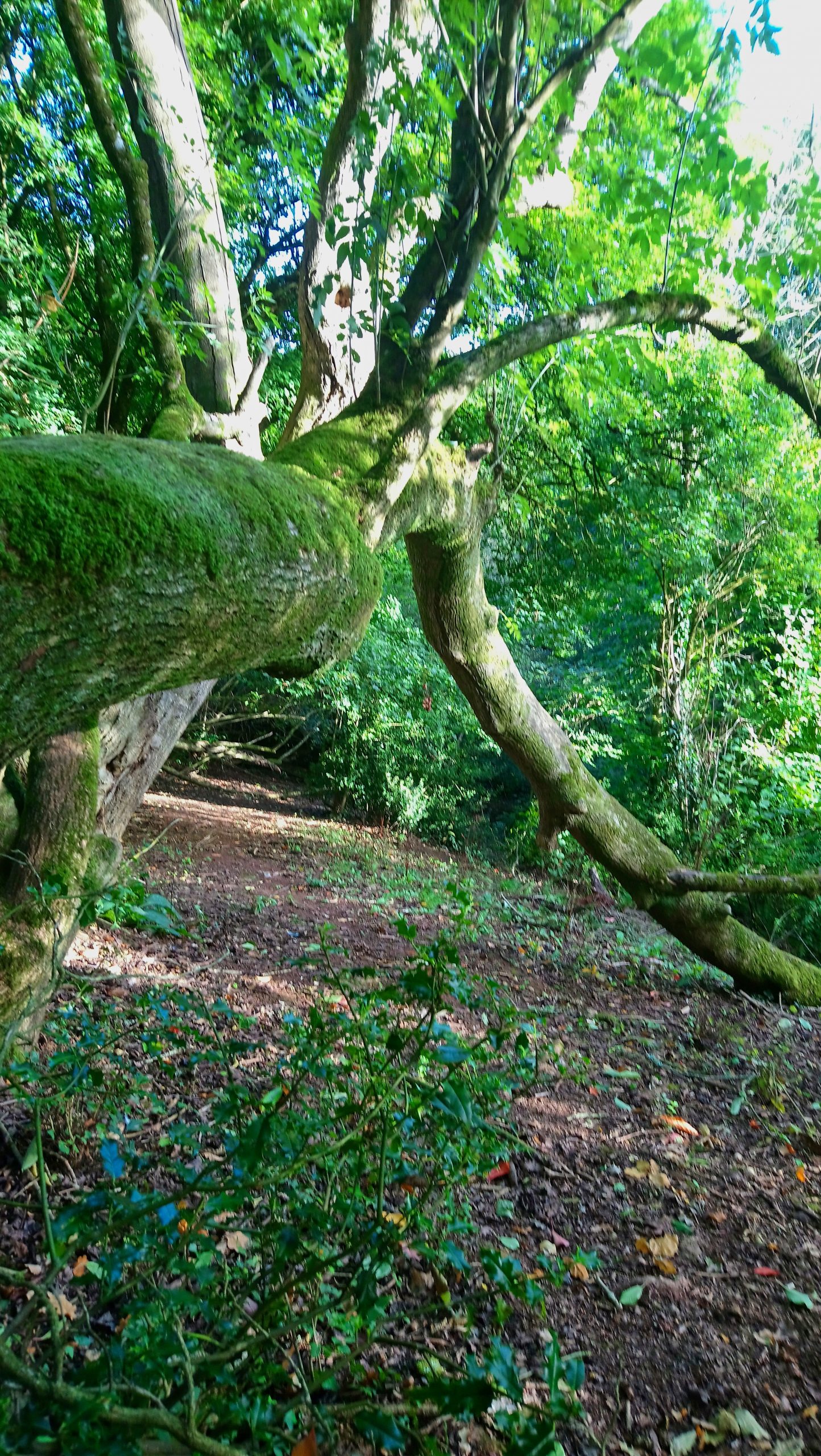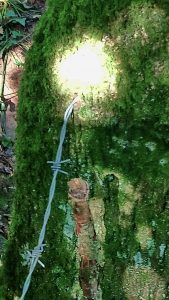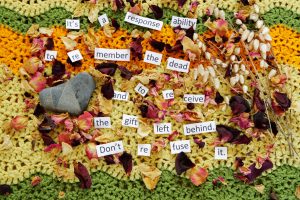Very early on in my enquiry into desire – 3 years ago – I found myself drawn to the story of The Descent of Inanna to the Great Below, a Sumerian myth written down in cuneiform script on clay tablets about 4,000 years ago. Sumer, as a distinct land and culture, was already 1,000 years old by then, having emerged over millennia in an area where agriculture began – what is now southern Iraq. It was able to develop because these people discovered how to irrigate the land. Although Sumer had two great rivers running through it, the Tigris and the Euphrates, it was basically desert-like. For drinking water, people relied on deep wells. Once they understood how to irrigate their fields, increasing the yield of their crops, cities were eventually able to develop and, with them, an elaborate and highly sophisticated culture, including art, music and literature. It is this culture that is so beautifully evidenced in the clay tablets. For my understanding of this story I drew on two translations: SN Kramer’s and the University of Oxford’s Electronic Text Corpus of Sumerian Literature, both of which you can read for yourself.
But the first stirrings happened when, in the autumn of 2016, I was asked in a poetry class to try to write from the point of view of a mythological character. Ereshkigal popped immediately into my mind, despite my not having thought of this myth for many years. The poem (see below) came out as a whole in a 10 minute writing exercise and has not needed to be changed or developed since. This rarely happens for me. As I reflected on Ereshkigal’s words, I wondered, “What desire led Inanna into attempting to do such a deadly dangerous thing?” Inanna was the Queen of Heaven and Earth, the Great Above. In cosmology she was the morning and the evening star, shining and beautiful. She was dynamic, passionate and overtly sexual – desire itself. She was also the goddess of war, fierce in the defense of her people. At the time Inanna decided to take this journey, she was no longer a young goddess. She was in the fullness of her power. Her consort was Dumuzi, the great Shepherd-God, King of Uruk, Inanna’s special city. She had two grown sons, both of whom were kings in other cities. She had the love of her people and many temples devoted to her.
The Descent is clearly a myth of the cycles of nature, of the connection between birth and death, reflected in the processes of sowing, growing and harvesting grain. But, like all great stories, it comes across as more complex than that, with many possible layers of meaning. It is a shamanic journey, where wisdom is brought back from the underworld at great cost. It has been given the full Jungian treatment as a story of psychological transformation.1 I, myself, have used it to help a therapy client make sense of her depression. On yet another level the story can be seen as a family drama. Sumerian mythology has a family structure and the characters are all enmeshed in close relationships. Ereshkigal was described as Inanna’s sister. Enki, who as the God of Wisdom and of the Deep, Sweet Waters is a key element in the outcome of the story, was their maternal grandfather. Nanna was Inanna’s father and Enlil was her paternal grandfather. Inanna’s close servant, advisor, companion and friend was Ninshubur, who was a Queen from the East in her own right. My interest was in looking at the story from the perspective of desire – What did Inanna feel she wanted? It must have been a deep desire for her to take such a huge risk. Did she know what it was she wanted? – or was there just a deep “wanting”?
At the beginning of the story, Inanna “opened her ear to the Great Below. She set her mind on the Great Below”. Samuel Noah Kramer, who was one of the translators of the tablets, tells us that the word for “ear” and for “wisdom” are the same in Sumerian, and that it can also mean “mind”. And he says that the word translated as “opened” can mean “set”. Inanna specifically placed (set) her mind (ear) on the Great Below.2 What motivated her to do this and what she felt about it are not told, although, given the choice of words, the desire for wisdom or knowing seems to have been part of it. She just determined to go. The story also speaks in terms of abandonment. She abandoned her people and her temples. She abandoned the Great Above. She left everything behind her to make this journey.
She prepared by taking to herself the seven “me”, her divine powers, in the form of the garments she wore. Then she called for Ninshubur and together they made their way to the Gates of the Underworld. There, Inanna told Ninshubur she needed her to wait outside the gates for her return. If she didn’t come out in three days, Ninshubur was to take on all the attributes and garments of mourning and go to Inanna’s powerful grandfather, Enlil, and ask him to intervene. If he refused, then she was to go to Nanna, Inanna’s father, for help. If this proved fruitless as well, then she must go to Enki, because “He knows the secrets” and would know what to do.
Then Inanna knocked loudly on the gates, which were guarded by the gatekeeper, Neti. He didn’t understand why anyone would voluntarily want to come in and asked her, “Why has your heart led you on the road from which no traveller returns?” Inanna announced it was because of her sister, Ereshkigal – and because she wanted to witness the funeral rites of her sister’s husband, The Bull of Heaven. This last seems spurious to me and is never mentioned again, but the first rings true – she wanted to see her sister. But why, and why now? Here may lie the family drama. Whatever the reason, Ereshkigal was not pleased when Neti brought her the news that her sister was outside the gate, demanding entrance. Basically, she was being put into the position of having to commit sororicide. She told Neti that he was to allow Inanna through the gates, all seven of them, but he must only lift each gate a little, so that she must crouch down in order to enter – and he was to remove one of her garments at each gate, thus divesting her of her divine powers. The first time this happened, Inanna was indignant – but Neti firmly told her that she was not to question the ways of the underworld. It seems to me that it must have been at this point, before which Inanna was every inch the proud and powerful goddess, that she realised the journey would not be on her own terms. By the time she reached Ereshkigal, Inanna was naked and on her knees.
INANNA
Unlike the burning passion
I know so well –
hot, sticky and raging –
this desire rose cool and sharp
from deep inside me –
to see her, to touch her and know.
It would not let me rest.
I knew it would be risky
to go to my sister’s house,
so I left explicit instructions
with the woman I trusted most.
Even if the others refused,
the old man by the water
would not let me down.
Pierced through by longing
to hear her dark secrets,
the deeper I went
the less of me there was.
And when I looked up
into her obsidian eyes.
I knew I would know.
ERESHKIGAL
She wanted to come –
my beautiful, sparkling sister –
to visit me.
From where she danced in the sky –
kissing the moon –
she could not see me,
so failed to understand.
As much as I loved her, she needed to know
she could not just drop in for a chat.
So I stripped her of all her pretty things.
She could have turned back,
but she always was game for a lark –
up for a dare. Even as a child
she would lead the way –
lifting up latches of doors
we were not meant to enter –
peering into places
we were not meant to see.
Here, I am in charge and I know this place.
The mysteries of darkness and death
are in my care –
not for the curious.
When finally she arrived –
naked and expectant –
I pulled off her shining skin
and hung up her dripping body.
She needed to understand her limits.
Outside the gates, Ninshubur waited the allotted three days, and then carefully followed the instructions Inanna had given her. Both Enlil and Nanna refused to intervene, maintaining that Inanna well understood that going to “the Dark City” was a one-way trip. It is interesting that in both translations these gods describe Inanna as having “craved” the Great Below – they believed she desired something there. Ninshubur had to place all her hopes onto Enki.
NINSHUBUR
I did not want her to go.
But when she told me to stand guard –
to hold vigil – I thought:
I am a woman.
I know how to wait.
Her father and grandfather
dared not come between
these two puissant sisters.
I saw fear in their eyes,
and felt rage and despair.
So to the deep, sweet water
I walked and sat down.
I tore at my hair, called out my grievance.
The old man received me with
kindness and tears – then set to work.
ENKI
I heard her pain and grief
long before word arrived –
my skin tightened –
my bones ached.
This dark, solemn sister,
so aware of necessity,
knew she had no choice.
I remember them both
in my heart’s mind.
My fingers remember
the touch of their hair –
one like a raven’s wing –
the other, liquid light.
Two hearts beating in time.
Long separated –
co-existence not an option –
it was only a matter of time
before the shining one,
so full of possibility,
would seek the other out.
I choose to heal them both.
Enki pulled a little bit of dirt from under a fingernail on one of his hands and fashioned it into a tiny being, with no gender, and he called it a Kugara. Then he pulled a little bit of dirt from under a fingernail on his other hand and fashioned it into another tiny being, with no gender, and he called it a Galatura. To the Kugara he gave the Water of Life and to the Galatura he gave the Food of Life. He told them to swiftly go down to the Gates of the Underworld and squeeze under them. He said they would not be noticed because they were too small and they had no gender. When they came into the presence of Ereshkigal, they would find her in great pain and unattended. When she cried out, they must cry out too. When she groaned, they were to groan with her. When she moaned, they must moan too. Then she would notice them, and she would be grateful that her pain had been witnessed and shared. She would offer them a reward – anything they liked from all the riches of the world. But they were to refuse anything she offered, and ask only for the body up on the hook – and she would give it to them.
KUGARA AND GALATURA
We are Enki’s emissaries.
We are not much – a pinch of dirt each.
Like flies we flit to and through the dark gates.
We are not much – a pinch of dirt each.
It’s life we carry – and the old man’s love.
We are not much – a pinch of dirt each.
She’s alone and unaided – we come to her side.
We are not much – a pinch of dirt each.
We hear her cry out – we hear her groan.
We are not much – a pinch of dirt each.
We hear her pain – take her pain as our own.
We are not much – a pinch of dirt each.
She is birthing in death and dying in birth.
We are not much – a pinch of dirt each.
We echo her cries and offer our tears.
We are not much – a pinch of dirt each.
She’s no longer alone – no longer unheard.
We are not much – a pinch of dirt each.
She blesses our presence, gives us the dead.
We are not much – a pinch of dirt each.
Both queens are restored by the water of life.
We are not much – a pinch of dirt each.
Revived to themselves, healed of their strife.
We are not much – a pinch of dirt each.
The smallest of gestures can cross deep divides.
It need not be much – a glance or a word.
I’m here and I see you – I’m touched by your pain.
Empathy’s emissaries.
And so Inanna was restored to life by the intercession of Enki’s tiny beings, and she began her journey back to the Great Above. I want to leave the story there. What comes next is rich and interesting, but it doesn’t shed any more light on what desire drew Inanna to make the descent in the first place. I told this story, including reciting the poems, to an audience at Wootton Fitzpaine parish hall. It was well received and, afterwards, I asked them what deep desire they thought led Inanna to go on such a dangerous journey. Some answers were along the family drama line, the sister-thing; some along the more shamanic line and many along the line of the need to bring together the opposites of light and dark, life and death. A child in the audience said she thought Inanna had become dissatisfied with having everything she wanted, and desired to know what it was like to have nothing. Of course, all of these answers are valid. Here are my thoughts:
The child is right. Inanna was filled to the brim with the delights of heaven and earth. It was what she knew and she felt confident and powerful there. But she did not know death. She was aware of death, but had no deep knowledge of it. She must have sensed the power of it – something she could not get at – could not understand. This left her with a sense of absence, of lack, and therefore of longing. The desire for the underworld is about what you want and don’t know, not about what you know and want. It involves that intense sense of wanting to penetrate something you feel is there somewhere, just out of sight, just out of reach. It requires going deeply inwards, into the dark.
There are times in life when death reaches out and touches you. Then the need, the desire even, wells up inside to understand what it really means. From childhood onwards, it has come up many times in my life – death’s existential mystery. Sometimes it has been just a soft brushing past and sometimes it has been a hard blow. Since the death of my parents and then of several friends, mostly younger than me, combined with the undeniable aging of my own body, my awareness of the nearness and elusiveness of death appears on an almost daily basis.
I am beginning to see that my explorations into fear, creativity and vulnerability all have been, to some extent, a response to this call from the Great Below. But I have also been passionately listening to the call of the Great Above. I hear it in the song and flight of birds, see it in the soft look in another’s eyes, feel it in the shock of moorland or sea air in my lungs. Desire is about life and, for me, about wanting to feel fully alive. I don’t think Inanna wanted to lose her life. It’s more like she wanted to add death to her life. I think my bringing together of fear, creativity, vulnerability and desire have been further enabling me to “open the gates” – and these gates have levels of meaning, just like the story of Inanna has. My deep desires are around feeling fully connected to my place in being. This includes both death and life.
1Perera, S.B. (1881) Descent to the Goddess, A Way of Initiation for Women; Toronto, Canada; Inner City Books.
2Wolkstein, D & Kramer, S N (1983) Inanna, Queen of Heaven and Earth, Her Stories and Hymns from Sumer; New York, Cambridge, Philadelphia, Sand Francisco, London, Mexico City, Sãn Paulo, Sydney; Harper & Row Pub.

